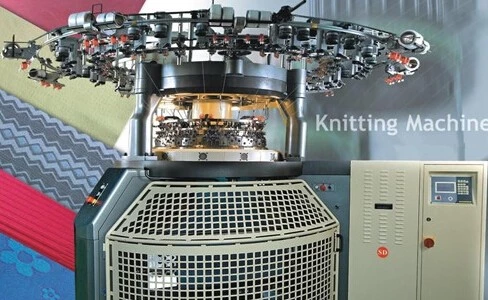Principles and Key Debugging Points of the Shifting Rib Circular Knitting Machine
Jan 11, 2024
The Shifting Rib Circular Knitting Machine has consistently been a popular choice in the textile industry. This article will introduce the principles and key debugging points of the Shifting Rib circular Knitting Machine.

In the mechanism of the circular knitting machine's rib circle shift, the initial coil movement involves manipulating the needles on the dial. The needle grooves within the cylinder accommodate the latch needle plate, secured by an expanding ring with a spring steel sheet. One end of the sheet attaches to the needle bar, while the other end approaches the knitting needle bar groove. This assembly includes an incision, also known as the shoulder piece, on the expanding circle piece.
A triangular-base shift ring, exclusive for moving coil mechanisms like flower discs, put chips, inserts, and rollers, is installed on the machine. The needle circle needs to rise above the ring's back location. Here, the expanding circle piece penetrates the coil, expands, and rests on the incision. The needles on the disc move outwardly, guided by the needle bar and diffuser ring, forming voids that engage the dial needles. As the syringe needles descend, the coil slides off, transferring to the needle plate. When the needle reaches the next loop system, the tongue opener releases the coil from the syringe needles, preparing for the next weave.
The shifting circle, or leno, in rib-knit organization involves selectively shifting some ring coils to create varied patterns on the fabric surface. This dynamic technique, with different organization types and shifting circle methods, yields a variety of pattern effects.
When debugging the rib machine's shifting circle:
1. Ensure the security of the rib machine by covering the needle with a dial cloth to prevent snagging.
2. Adjust the coil length appropriately, avoiding excessive tension mutations during elastic expansion.
3. Maintain moderate coiling tension to prevent holes while ensuring smooth weaving progress.
4. Take note of the needle pressure during lag into a circle to prevent holes.
5. Control yarn tension between 4.9 to 7.84 cN for optimal results, avoiding both holes and needle leakage.

In the mechanism of the circular knitting machine's rib circle shift, the initial coil movement involves manipulating the needles on the dial. The needle grooves within the cylinder accommodate the latch needle plate, secured by an expanding ring with a spring steel sheet. One end of the sheet attaches to the needle bar, while the other end approaches the knitting needle bar groove. This assembly includes an incision, also known as the shoulder piece, on the expanding circle piece.
A triangular-base shift ring, exclusive for moving coil mechanisms like flower discs, put chips, inserts, and rollers, is installed on the machine. The needle circle needs to rise above the ring's back location. Here, the expanding circle piece penetrates the coil, expands, and rests on the incision. The needles on the disc move outwardly, guided by the needle bar and diffuser ring, forming voids that engage the dial needles. As the syringe needles descend, the coil slides off, transferring to the needle plate. When the needle reaches the next loop system, the tongue opener releases the coil from the syringe needles, preparing for the next weave.
The shifting circle, or leno, in rib-knit organization involves selectively shifting some ring coils to create varied patterns on the fabric surface. This dynamic technique, with different organization types and shifting circle methods, yields a variety of pattern effects.
When debugging the rib machine's shifting circle:
1. Ensure the security of the rib machine by covering the needle with a dial cloth to prevent snagging.
2. Adjust the coil length appropriately, avoiding excessive tension mutations during elastic expansion.
3. Maintain moderate coiling tension to prevent holes while ensuring smooth weaving progress.
4. Take note of the needle pressure during lag into a circle to prevent holes.
5. Control yarn tension between 4.9 to 7.84 cN for optimal results, avoiding both holes and needle leakage.
Next: Yuanda Double Jersey Circular Knitting Machines are Working for the Customer's Factory
Previous: Selecting the Right Cam for Your Circular Knitting Machine
About Us
We have been committed to manufacturing all types of circular knitting machines with great quality and reasonable price for a long time. Our professional team is highly specialized and problem-solving oriented. We put the most effort into meeting your knitting demands, achieving a win-win situation.
Categories
Useful Links
